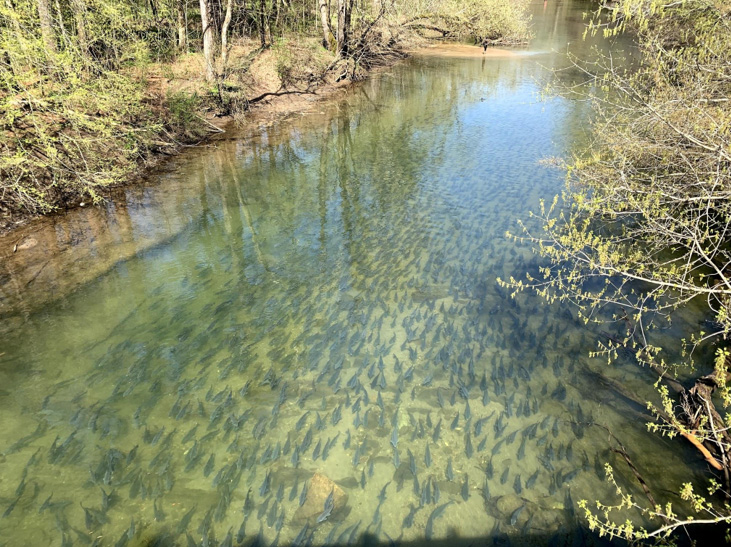Biodiversity and Ecology

The aquatic animals living in certain water sources can be indicators of water quality.
The overarching objective of this area is to enable basic and applied research related to aquatic ecosystem conservation and management. Current research interests among faculty members in this area are diverse, mainly covering endangered, invasive, and game species management; food webs; biogeochemistry; climate change impacts; and ecosystem services. The biological groups of interest include bacteria, algae, macroinvertebrates, fishes, amphibians, reptiles, waterfowl, and bats, as well as genetic-based detection and conservation strategies for many of these groups. Twelve faculty in the Department of Biology, School of Environmental Studies, and USGS Cooperative Fishery Unit are active in this area.
Research Focus Area Leader: Dr. Justin Murdock, Biology

Research Spotlight
Every spring in east Tennessee, tens of thousands of fishes called buffalo make the short trip upstream from Tellico Reservoir into a small tributary called Citico Creek to reproduce. Although their journey is far less dramatic than the much-celebrated salmon of the Pacific Northwest, these buffalo likely share at least one important similarity with the salmon: through their migrations, they transport large quantities of essential nutrients between aquatic habitats. Given their ability to act as conveyor belts of materials that fuel production in habitats used for spawning, researchers at Tennessee Tech are left to wonder, are suckers the salmon of the South?
- Faculty
- Dr. Bradley Cohen, Biology
- Dr. Joshua Hall, Biology
- Dr. Carla Hurt, Biology
- Dr. Hayden Mattingly, Environmental Studies
- Dr. Justin Murdock, Biology
- Dr. Mark Rogers, TN Cooperative Fishery Unit
- Dr. Amanda Rosenberger, TN Cooperative Fishery Unit
- Dr. Christopher Wheeler, Biology
- Students
- Awards and Recognition
- Biology Professor Hayden Mattingly won a Tennessee Tech Faculty Non-Instructional Assignment for a proposal to write and edit a special issue on aquatic fauna of the Barrens Plateau for the Southeastern Naturalist. His was one of only two non-instructional assignments awarded by the University in 2019.
- Biology Assistant Professor Brad Cohen was invited to present "Mallard Movements and Habitat Use in West Tennessee: Project Summary," co-authored by N.M. Masto, A.G. Blake-Bradshaw, and C. Highway, to the Dyer County Ducks Unlimited Varsity, in Dyersburg, Tennessee, in 2019.
- Biology Associate Professor Justin Murdock was invited to present "Wetland Reserve Program Research in Tennessee," coauthored by S. Morris, to the USDA NRCS Tennessee State Technical Committee in Murfreesboro, Tennessee, in August 2019. He was also invited to present "Improving Nutrient Retention in Agricultural Watershed through Floodplain Wetland Restoration" during the Southeastern Water Pollution Biologists Association Annual Meeting, held in Chattanooga, Tennessee, in October 2019.
- Assistant Professor in biology Kit Wheeler's student Mack White won second place among all graduate student posters for his presentation titled "Abundance Estimates of Spawning Catostomids in a Small, Oligotrophic Stream Using Aerial Imagery" at the Southeastern Fishes Council Meeting, held in Knoxville, Tennessee, in November 2019.
- Amanda Rosenberger, assistant unit leader of the Tennessee Cooperative Fishery Research Unit and associate professor of biology, was part of the WingsUp 100 group of researchers who earned more than $100,000 in the 2018-2019 fiscal year. Also, her article (Laske et al., 2018) was recognized as the Top Downloaded Article from 2017-2018 by the Ecology of Freshwater Fish. She was invited to present "Modeling Fundamentally Suitable Freshwater Mussel Habitat in the Duck River Drainage, Tennessee," coauthored by B. Bajo, during the Organization of Fisheries and Wildlife Information Managers Annual Meeting, held in West Virginia in October 2019.
- Projects
- Factors Affecting Sanctuary Use by Mallards
Bradley Cohen/U.S. Fish and Wildlife Service - Developing Waterfowl Monitoring Protocols
Bradley Cohen/U.S. Fish and Wildlife Service - Waterfowl Resting Areas
Bradley Cohen/Tennessee Wildlife Resources Agency - Mallard Use of West TN
Bradley Cohen/Tennessee Wildlife Resources Agency - Tennessee Secretive Marshbird Monitoring Project
Bradley Cohen/Tennessee Wildlife Resources Agency - Banding Project to Investigate Gobbler Harvests
Bradley Cohen/Tennessee Wildlife Resources Agency - Multi-State Banding for Gobbler Harvest Rates
Bradley Cohen/Kentucky Department of Fish and Wildlife Resources - Wild Turkey Repro Study II
Bradley Cohen/Kentucky Department of Fish and Wildlife Resources - Assessing Thermal Responses of Streamside Salamanders
Joshua Hall/Tennessee Wildlife Resources Agency - Snapping Shrimp
Carla Hurt/National Science Foundation - Assessing Biodiversity in Stream-Dwelling Crayfish
Carla Hurt/Tennessee Valley Authority - Streamside Salamander Impact
Carla Hurt/Tennessee Wildlife Resources Agency - Hardin Crayfish and Pristine Crayfish
Hayden Mattingly/U.S. Fish and Wildlife Service - Population Monitoring Plan for Brawleys Fork Crayfish
Hayden Mattingly/Tennessee Wildlife Resources Agency - Harmful Algal Blooms and Toxin Production
Justin Murdock/Marshall University - Contaminants in Bat Food Sources
Justin Murdock/U.S. Army Corps of Engineers - African Walking Catfish
Mark Rogers/U.S. Fish and Wildlife Service - Slender Chub
Mark Rogers/U.S. Geological Survey - Bighead & Silver Carp Population Dynamics
Mark Rogers/U.S. Geological Survey - Asian Carp Controls
Mark Rogers/U.S. Geological Survey - Evaluation of Asian Carp Populations
Mark Rogers/Tennessee Wildlife Resources Agency - Evaluation of Invasive Carp in Tennessee and Cumberland Rivers
Mark Rogers/Tennessee Wildlife Resources Agency - Aquatic Research Sport Fish Restoration
Mark Rogers/Tennessee Wildlife Resources Agency - Wolf River Mussel Fauna
Amanda Rosenberger/U.S. Geological Survey - Tennessee Heelsplitter
Amanda Rosenberger/U.S. Geological Survey - Mussels in Hatchie River
Amanda Rosenberger/U.S. Fish and Wildlife Service - Cub Creek - Lone Oaks Study to Characterize Fish Community
Amanda Rosenberger/Tennessee Department of Environment & Conservation - DNA Surveillance of the Chucky Madtom
Amanda Rosenberger/Tennessee Wildlife Resources Agency - A Reassessment of the Pale Lilliput
Amanda Rosenberger/Tennessee Wildlife Resources Agency - DNA Surveillance of Duskytail Darter
Amanda Rosenberger/Virgina Department of Wildlife Resources - River Chubs as Keystone Species in the Little River BasinChristopher Wheeler/Tennessee Valley Authority
- Barrens Topminnow Population in the Middle Collins River
Christopher Wheeler/Tennessee Wildlife Resources Agency - Sicklefin Redhorse Migrations
Christopher Wheeler/The Sicklefin Redhorse Conservation Committee
- Factors Affecting Sanctuary Use by Mallards
- Publications/Presentations
Journal Articles (Fiscal Year 2019-2020)
- Chilton, J., A.E. Rosenberger, and R.J. DiStefano. (2020). Habitat associations and distributions of two endemic crayfishes, Cambarus (Erebicambarus) maculatus (Hobbs & Pflieger, 1988) and Faxonius (Billecambarus) barrisonii (Faxon, 1884)(Decapoda: Astacoidea: Cambaridae), in the Meramec River drainage, Missouri, USA. Journal of Crustacean Biology.
- DiStefano, R.J., J.T. Westhoff, C.J. Rice, and A.E. Rosenberger. (2019). Life history of the endemic saddleback crayfish (Faxonius medius) (Faxon, 1884), (Decapoda: Cambridae) in Missouri, USA. Freshwater Crayfish, 24, 1-13.
- Hurt, C., R.F. Thoma, D.I. Withers, C.E. Williams, and R.T. Paine. (2019). Extensive regional endemism and cryptic diversity in the Tennessee and Kentucky, USA, populations of the burrowing crayfish Cambarus deweesae (Bouchard & Etnier, 1979)(Decapoda: Astacidea: Cambaridae) as revealed by molecular genetics. Journal of Crustacean Biology, 39, 440-440.
- Perkin, J.S., W.K. Gibbs, J.L. Ridgway, and S.B. Cook. (2019). Riverscape correlates for distribution of threatened spotfin chub (Erimonax monachus) in the Tennessee River basin, USA. Endangered Species Research, 40, 91-105.
- Spaulding, J., and M. Rogers. (2019). Smallmouth bass population characteristics and minimum length limit evaluation for Elk River and Richland Creek in Tennessee. Proceedings of the Southeast Association of Fish and Wildlife Agencies.
- Wells, W.G., and H.T. Mattingly. (2019). Preliminary analysis of age-class structure and longevity for the endangered Pygmy Madtom. Copeia, 107, 447-450.
Publications in Press (Fiscal Year 2019-2020)
- Wells, W.G., and H.T. Mattingly. Evaluation of microhabitat conditions use by Noturus stanauli (Pygmy Madtom) in the Clinch River, Tennessee. Southeastern Naturalist.
- Wells, W.G., and H.T. Mattingly. (2020). Evaluation of benthic fish communities in the Clinch and Duck rivers as habitat indicators for the endangered pygmy madtom, Noturus stanauli. Southeastern Fishes Council Proceedings.
Presentations (Fiscal Year 2019-2020)
- Allen, S.A., W.G. Wells, and H.T. Mattingly. "A Large-Scale MaxEnt Model for the Distribution of the Endangered Pygmy Madtom, Noturus stanauli," presented at the Catfish 2020: Third International Symposium, Little Rock, Arkansas, February 2020.
- Bajo, B., and A.E. Rosenberger. "Modeling Fundamentally Suitable Freshwater Mussel Habitat in the Duck River Drainage, Tennessee," invited presentation to the Organization of Fisheries and Wildlife Information Managers Annual Meeting, West Virginia, October 2019.
- Bouska, K., A.E. Rosenberger, K. Key, J. Holtswarth, G. Linder, and S. McMurray. "Development and Implementation of a Strategic Mussel Conservation Assessment in Missouri," presented at the Midwest Fish and Wildlife Resources Conference, Springfield, Illinois, January 2020.

